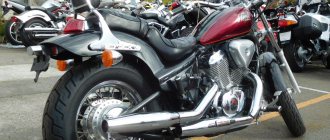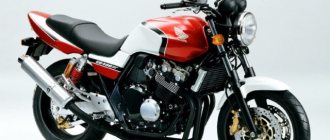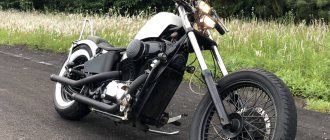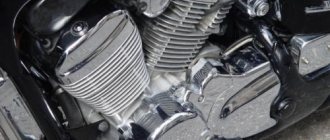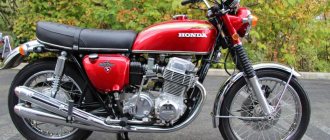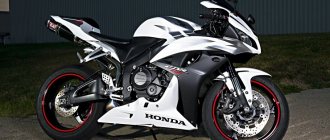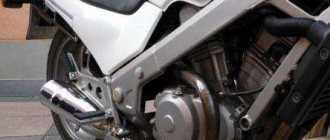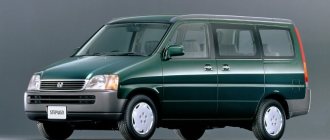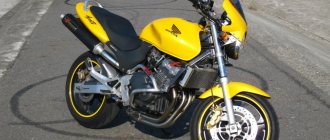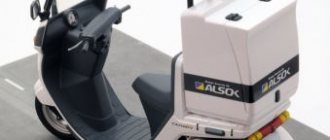Japanese motorcyclesHonda motorcycles
Japanese motorcycle manufacturers have long and firmly occupied a leading position.
Moreover, they occupy this position in almost all classifications of motorcycles.
Some of the companies are engaged in the production of sports and cross-country cars, but the Honda company is mostly famous for its cruiser motorcycles .
This company at one time tried to take a leading position in the American market, which led to the production of motorcycles made in the American style.
First, such a motorcycle was the Honda Shadow, which appeared in 1981, later, namely in 1988, some Shadow models were replaced by a new motorcycle - the Honda Steed.
The company prepared the Honda Steed 600 model for the American motor market, and a little later, for the domestic market, it released the Honda Steed 400 model.
There was also a Honda Steed 750 model, but it did not gain popularity and its production was discontinued.
A little history of the model
Although the Honda Steed 400 motorcycle models were initially produced for the domestic market, over time they decided to release it on other continents. The production of this motorcycle began in 1988.
And this model existed until 2001.
We can say that this motorcycle has two generations in its history.
The first generation was produced until 1996, then the second generation was produced.
Although the division into generations of this motorcycle can be considered conditional, since no special changes were made to the design, there were only minor changes in appearance.
In addition, the Steed 400 motorcycle line has 4 versions. The regular version of the motorcycle had the letter VLX in its designation.
This version of the motorcycle was produced throughout all years of production. There was also a VLS model.
This model, unlike the standard one, had a chrome-plated springer front suspension. This made it possible to install a 21-inch front wheel on the motorcycle.
In addition, the saddle height of this version was 20 mm lower than the standard one. This model was produced from 1996 until the end of production.
There was also a model designated VSE. The only difference from the base model was the rear wheel.
This version was equipped with a solid disc instead of a spoke one. The latest version was designated as VCL, the full version name was Custom Edition.
What do we do with the information we collect?
We use personal data to provide you with the services you ask us to provide. Unless you notify us that you no longer wish to receive this type of information, we may provide you with periodic communications about our products and services. By providing us with your personal information by email or telephone, you consent to our use of your information in the manner described in this paragraph.
We may conduct statistical analyzes of user behavior (for example, by analyzing website usage data collected passively from all users) to determine the relative degree of consumer interest in different areas of our website. Such analysis will help us in our efforts to further improve the product.
Design features of the motorcycle
Honda Steed 400 is a light cruiser made to suit American needs.
The motorcycle had a frame design with a low seat position. At the front, a telescopic fork was most often used, although, as already mentioned, there were also models with a “springer” .
The motorcycle was equipped with a teardrop-shaped small tank. Structurally, the driver's seat was close to the steering wheel; as conceived by the designers, this gave the motorcycle a certain dragster-like appearance.
The seat itself had a stepped shape, so that the passenger was higher than the driver. Some models of the seat were additionally equipped with a backrest.
All versions of the motorcycle were equipped with a V-shaped 2-cylinder engine with 4 strokes and 3 valves for each cylinder.
What is noteworthy is that this motorcycle was produced for a long time, but the engine was not subjected to any modifications . All data on the power plant and general performance of the motorcycle will be below.
On the Kawasaki Ninja 600, the pilot can easily climb a couple of steps onto the podium.
This representative of the Kawasaki lineup is comfortable and easy to drive, both in urban conditions and on the highway.
Advantages and disadvantages of the model
Despite its popularity, the Honda Steed 400 had several disadvantages. Belonging to the “cruiser” classification, this motorcycle was not as such.
And all because of the suspension. Both the front and rear suspension of the motorcycle were short-travel and harsh.
Therefore, long trips on it were tiring for the driver.
The engine, although very reliable, was still rather weak for this motorcycle, especially if it was ridden with a passenger.
The low driving position , with the seat close to the steering wheel, was not always acceptable for tall people.
The tank of the motorcycle was also not in favor; it was very small in capacity.
Initially, the motorcycle was equipped with a tank with a volume of only 8 liters, later the tank volume was increased to 11 liters, although this is still small.
But this motorcycle also has enough advantages . An important advantage was the reliability and unpretentiousness of the engine. Its service life without problems exceeded 250 thousand km.
The same stiff suspension also played a positive role. Thanks to it, combined with a low center of gravity, this motorcycle had simply excellent handling.
Well, the advantage of the Honda Stith was its appearance. With relatively modest power plant performance, this motorcycle did not differ in appearance from more respectable motorcycles.
In addition, this motorcycle was and is often used to create “choppers”, and what is important is that the engine is usually not affected, and only the appearance has been changed.
The Honda Steed 400 has a top speed of around 130-140 km/h, which looks like it has unlimited power hiding there.
And the ride gives you a feeling of excellent dynamics and it seems that under you there is not a power unit of four hundred cubic meters, but much more.
Garage installation of Honda Steed NV 600 from MD CustomS Greetings to all motorcycle enthusiasts.
This is my second project, which I would like to present with pleasure to my brothers. But first I want to express my gratitude to my large family, my wife and children for their understanding and support. And also to my friends, and especially Alexey Shalaev, who did not remain indifferent. This time I will not burden the reader with the agony of choice, thoughts on how I chose the paint and other rubbish. But I want to get straight to the point and talk about building a custom car based on the Honda Steed NV 600.
Anyone who doesn’t want to read the text, for example, is tired after work or is simply annoyed by reading, I invite you to immediately look at the photo.
So - I got the motorcycle in post-accident condition. He was, to put it mildly, shaken. And there was nothing attractive about it except the engine and flights of fancy. Everything iron and plastic, as well as electric, was in such a ruined state that I was simply horrified by how it drove at all. But of course, all this affected the price, which suited me quite well. I bought it at a symbolic price of 50 thousand rubles, which by today’s standards is not even a “thousand” of greenery. As for the accident itself, according to the descriptions of the previous owner, he drove it to the car. He says it’s not his fault, but that doesn’t really matter. As a result, the steering wheel was bent, and the most difficult thing was the steering column. Surprisingly, the wheel, traverses, fork and even the wing were intact. The motorcycle was seized before me. The beaver was not tricky and consisted of removing the subframe and installing a single seat. In principle, that's all. There wasn't even a rear wing. Instead of a broken plastic seat, the space was covered with an old jacket of nice leatherette. My eyes rolled across the floor when I removed it and saw a fuel pump tied to a string, and wires melted from contact with the mufflers. On the plus side, as the former owner assured me, the carburetors were adjusted and the engine was ventilated. I bought it in Tyumen, I already wrote about it briefly. By the way, despite everything, the former owner turned out to be a very good and sympathetic person. I registered it without any problems, by blinding the police. That is, having installed a standard wing, seat, stopper and plastic, the steering wheel was straightened in a vice. It's good that it was all included. And after registration he began to work. Worked in winter. It flew by quickly or even unnoticed. The steering column was put in place on a makeshift slipway with the help of my good friend. And that was the hardest thing. Geometry control was carried out using a laser level and such and such a mother. And then the revision began. The frame appears to be somewhat overcooked. Boxes from a Soviet-era Pannonia motorcycle were installed. All the electrics and the fuel pump are hidden in them. I tried to follow the contour of the frame according to the shape of the drawers. I wanted to make the steering wheel high, but not so high that my hands would become numb. I didn’t come up with the shape of the steering wheel right away. At least ten sketches were drawn, but they all repeated already known rudders. I wanted a unique one, which was invented by Mendeleev in a dream. Hahaha. My wife looked at me like I was crazy when I grabbed a pencil in the morning. But here, too, the implementation was complicated by the need to bend the pipe on rollers. A week of searching and the pipe is bent. Many will find the lack of adjustment a controversial decision, since the steering columns are welded into the steering wheel. But for me everything is convenient. The rear fender is made from the remains of a Dnepr motorcycle fender. Accordingly, all the fasteners, the battery box, the rear fender struts, the license plate and brake light mount, as well as the seat are made of metal. The stock mufflers were unsaleable, so new ones were made from stainless steel. The design is semi-straight-through with flutes. The sound is moderately loud, but very bassy. During development and assembly, we purchased and installed the second cylinder cover gasket, brake disc, steering handles, turn signals, extended cables and brake hose, headlight, brake light from the same ZIL, tires and consumables.
After fitting, I started painting. The frame, pendulum, boxes, traverses, fork cups, wheels, speedometer and brake light housings, front fender and license plate mount are painted with polymer powder paint and varnish. The tank and rear fender are painted with Candy paint with flakes. The middle part of the tank and wing is sanded with an emery wheel and also covered with candy. The tank and wing are pin-stamped. The painting design was invented by me and executed by the wonderful master Alexey Cheredov. Pinstriping was invented by Alexey himself. To complete the details, certain accents are made of bronze. On the crossbar, handlebar grips, rear fender mounting bolts, headlight mounting, mufflers and running boards. The saddle is also made independently. I have long wanted to try my hand at leather embossing. I was pleased with the result. I got exactly what I had in mind. It took a week to make, including embossing, drying, gluing, stitching and painting. For the first time I think it's good. What did you want to implement, but for objective reasons refused? I wanted to remove the airbox and free up the beautiful front cylinder cover for viewing. I refused because I would have to install zero-resistance filters and destroy the engine due to the huge amount of dust and sand. It’s a pity that, like in Moscow, our roads are not washed with shampoo. I wanted to remove the left and right stock remote controls. The right one was removed. But I left the left one for convenience and safety reasons. Yes, I have a small box for the steering wheel with small turn and signal buttons. But, having tried it on, I realized that I couldn’t use my leggings, and even with gloves. I wanted to not install the front wing. But, after driving a few kilometers, I came home and installed it. It’s not pleasant when sand flies in your face - once, and it knocks off the paint - twice. I would also like to fix all the chrome plating, as the chrome has bubbled everywhere from age. But we cannot solve this issue in any way. Chemical chromium is not taken into account, there is a lot of such stuff.
And my little point is the inscriptions in Latin. I named the motorcycle Custos solis - Guardian of the Sun. The words Libertas - Freedom / Fides - Faith / Honor - Honor / Iustitiae - Justice are written on the saddle. These words and the name reflect all my emotions invested in this motorcycle.
Now let's get down to business.
How it was:
How I made it: Thanks everyone for watching. Of course, there are no perfect motorcycles and this one is no exception. Someone will want to add or subtract something, but this is my picture and that’s how I see it))) Good luck to everyone on the roads and have a great motorcycle season 2016!
Motorcycle Specifications
Since the power plant did not undergo design changes, only a few parameters of the Honda Steed 400 motorcycles changed within a certain version, and even then only slightly. All of them are listed below:
| Technical characteristics of Honda Steed 400 | |||
| Parameter | Unit change | Index | |
| Models 1988-1996 | Models 1996-2001 | ||
| Engine | 4-stroke, 2-cylinder, V-shaped | ||
| S-ma cooling | Liquid | ||
| Power | 31 | ||
| Volume | See cube | 398 | |
| checkpoint | 5-speed | ||
| Tank | l | 8 | 11 |
| Length | mm | 2310 | 2310 — 2335 |
| Width | mm | 700 — 865 | 760 — 765 |
| Height | mm | 1105 — 1135 | 1115 |
| Clearance | mm | 140 | 130 |
Pros and cons of the Honda Steed 400
The obvious “advantages” include:
- reliability and service life of the engine and gearbox;
- appearance inappropriate for small volume;
- a huge number of parts for both repairs and modifications of the motorcycle.
The disadvantages of the Honda Steed 400 are as follows:
- the age of even the “youngest” motorcycles;
- large mass for a 400 cc V-twin engine with all the ensuing negative aspects;
- large mass of the motorcycle for the braking system.
Estimated cost
The Honda Steed 400 has not been produced for a long time , but its popularity has not yet decreased, and this is largely due to the successful design of the motorcycle.
Of course, it’s impossible to buy a new motorcycle now, but the secondary market offers a lot of options .
The cost of this motorcycle depends on many factors, including the year of production, technical condition, absence or presence of alterations, etc.
The price point for the Honda Steed 400 starts at 85,000 rubles. and reaches 200,000 rubles.
Due to its lightness, ease of use and reasonable price, a mini snowmobile is suitable not only for fishermen and hunters, but also for lovers of winter travel.
But you can learn everything about suitable equipment for driving this type of vehicle from this article.
Honda Steed 400 - classic and reliable
The Honda Steed 400 motorcycle, which belongs to the cruiser class (from the English Cruise - to travel), entered the Japanese motorcycle market in 1988. There are four known modifications of the Honda Steed 400, designated by the abbreviations VLX (1988), VCL - VSE (1995) and VLS (1998). In 2001, production of the Honda 400 was discontinued.
Advantages and disadvantages
The main advantage of the Honda Steed 400 is its high reliability. On the Russian second-hand motorcycle market, you can still find motorcycles from the first editions. These are devices from 1988-1989, which are in very good condition and can run for more than one thousand kilometers. From one repair to another, the engine can travel 30 thousand km, and this is not the limit.
The possibilities for tuning are very large: you can change the height of the steering wheel and seat if the owner is a tall person, adapt the frame to a springer, install new fenders, and so on. After a small modification, many external parts from the Harley Davidson, as well as the Russian Ural, fit perfectly into the Honda 400. “Native” parts for Honda are easy to find in Russia. Therefore, if the need for repairs arises, the motorcycle owner will not have any problems with it.
The Honda 400 has few shortcomings, but they still exist. Its main weakness is the suspension, and the reason for this is both in Russian road surfaces and as a result of tuning the front fork and/or rear swingarm - all this worsens the quality of the suspension. Another disadvantage is the modest volume of the gas tank. You have to refuel every 200 - 250 kilometers. The high cost of repairing a motorcycle is balanced by the fact that it does not have to be done very often (if the quality of the machine’s maintenance is sufficient).
Honda 400 - an example of Japanese quality
Since the last original Honda 400 rolled off the assembly line more than 16 years ago, Russian motorcycle enthusiasts have to buy cars with high mileage, having passed through a large number of previous owners who cared for their “steel horses” in different ways. Some are very good, some are very bad. However, even in the latter case, after putting it in order, the Honda 400 shows itself at its best, as evidenced by customer reviews. There is not a single negative one among them.
The main competitors of the Honda 400 in the Japanese motorcycle market include the Suzuki Intruder 400, Kawasaki VN 400 Vulcan, Yamaha XV 400 Virago. All these models have similar technical characteristics and are quite popular in Russia due to their high quality and relatively low cost. Also a competitor is the Honda Steed 600 - a motorcycle with similar characteristics, but more powerful.
Technical characteristics of Honda Steed 400
The motorcycle is distinguished by a long wheelbase and good driving performance. The technical specifications of the Honda Steed 400 are as follows:
- engine capacity – 398 cc;
- engine power – 31 hp;
- number of cylinders – 2;
- cylinder diameter – 64 mm,
- number of cycles – 4;
- number of valves per cylinder – 3;
- gearbox – five-speed;
- speed limit – 130 km/h;
- gas tank capacity – 11 l;
- Dimensions: length – 233.5 cm, width – 76.5 cm, height – 111.5 cm, ground clearance – 13 cm, weight – 196 kg.
The engine cooling method is liquid, the ignition type is electronic. Gasoline consumption per 100 km is 5.5 liters. The gear shift is smooth and precise, the run-up time to a speed of 100 km/h is 0-2 seconds. The motor runs smoothly, without sudden changes. The optimal speed is from 80 to 100 km/h; at higher speeds the car may tilt slightly. The grip of the wheels on the road is excellent. The braking system is reliable, but the driver should take into account that the weight of the motorcycle does not allow it to stop instantly.
Photo gallery
The appearance of the motorcycle is well-built, there is not even a hint of clumsiness; on the contrary, the silhouette captures swiftness.
Honda Steed is capable of attracting the interest of many buyers who adore choppers. See our photo selection and enjoy!
Video
This video gives us the opportunity to see how this “iron horse” behaves (this is the nickname the model received on the American market) not only on the track, but also while driving off-road.
It is noticeable that at speeds of up to hundreds of kilometers per hour, the motorcycle behaves amazingly; it seems that the driver does not feel any tension while driving.
Did you like the article? Tell your friends!
Comments (2)
- Arthur:
02/27/2015 at 17:25I think this model of motorcycle does not need unnecessary advertising. I dream of buying one for myself, my friends have already bought it and are enjoying riding it, they say it’s a pleasure. Well, thanks to this resource, I learned a lot of new and interesting things about this model, for which a special thank you.
Answer
- Yuri:
09/08/2016 at 16:52
The tank is not 8 but 9 liters, although this may have been the case on the 600 Steed. I had several of them in succession. and as you said, 11 liters is still not enough? I drove more than 300 km on a 600, and even more so on a 400, the steering generally eats very little. And regarding the VSE version, not only the rear wheel is different. rear fender, steering wheel, seat. panel. Thanks to the steering wheel, it looks much better than other versions.
Answer
